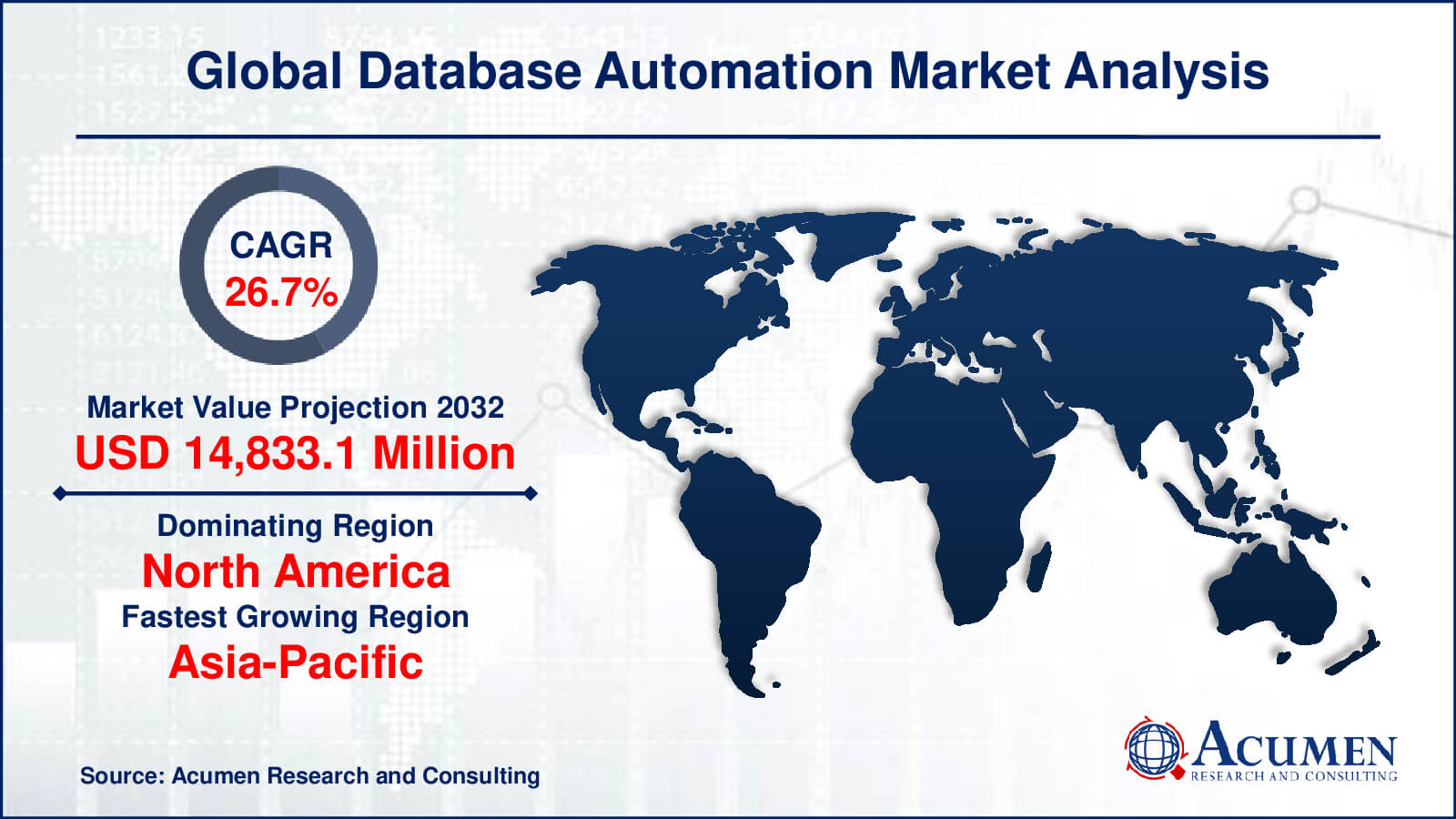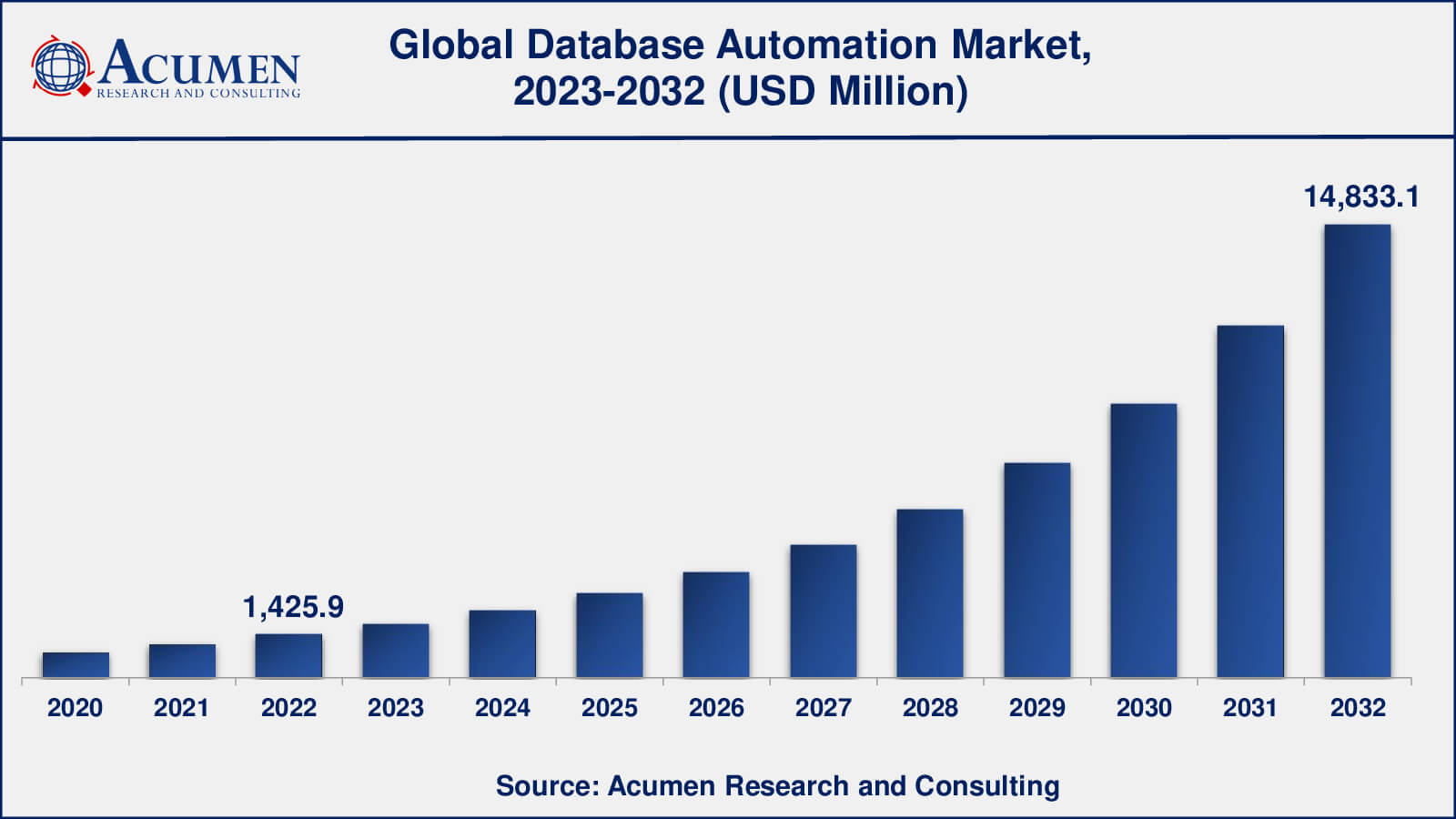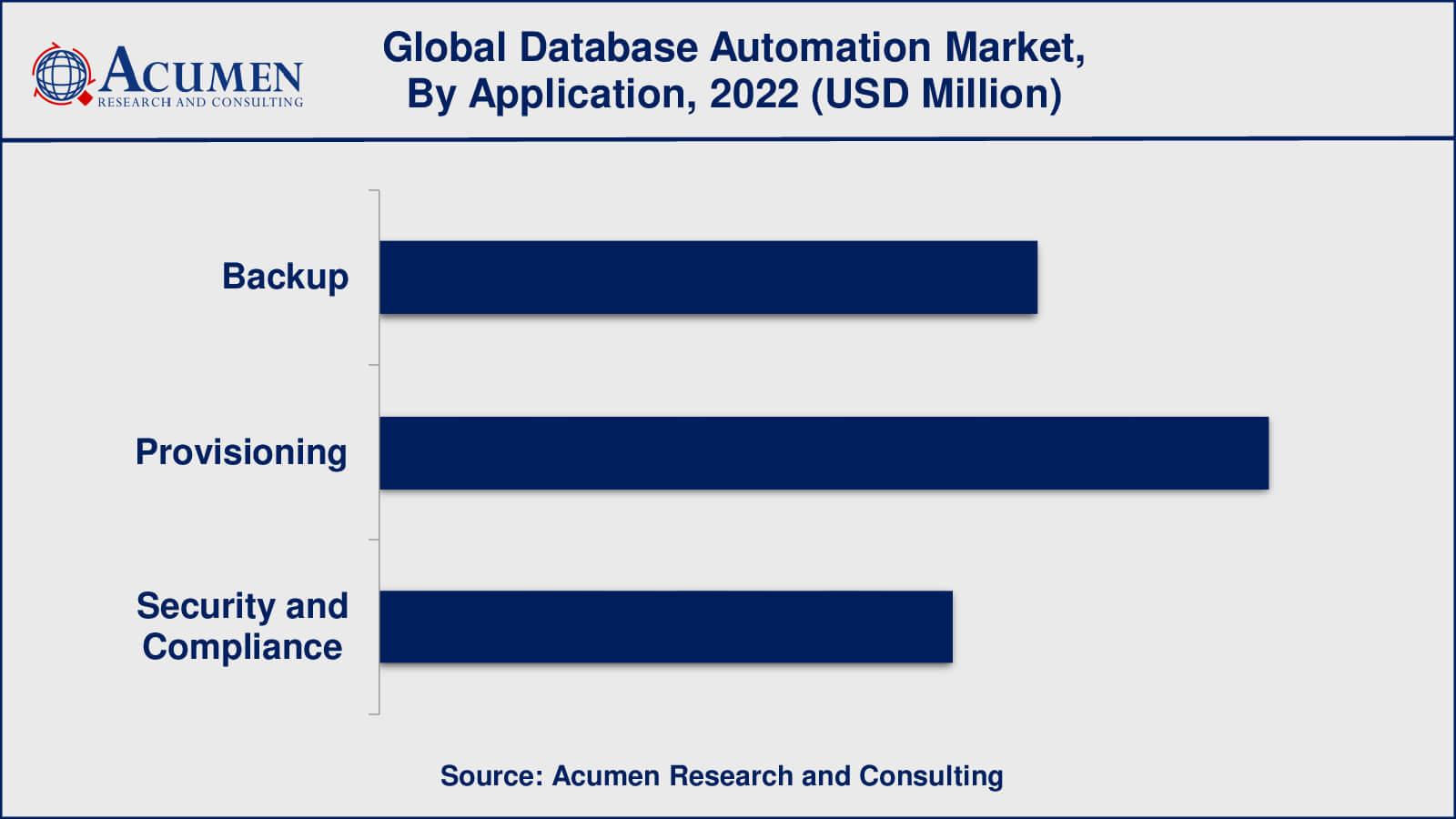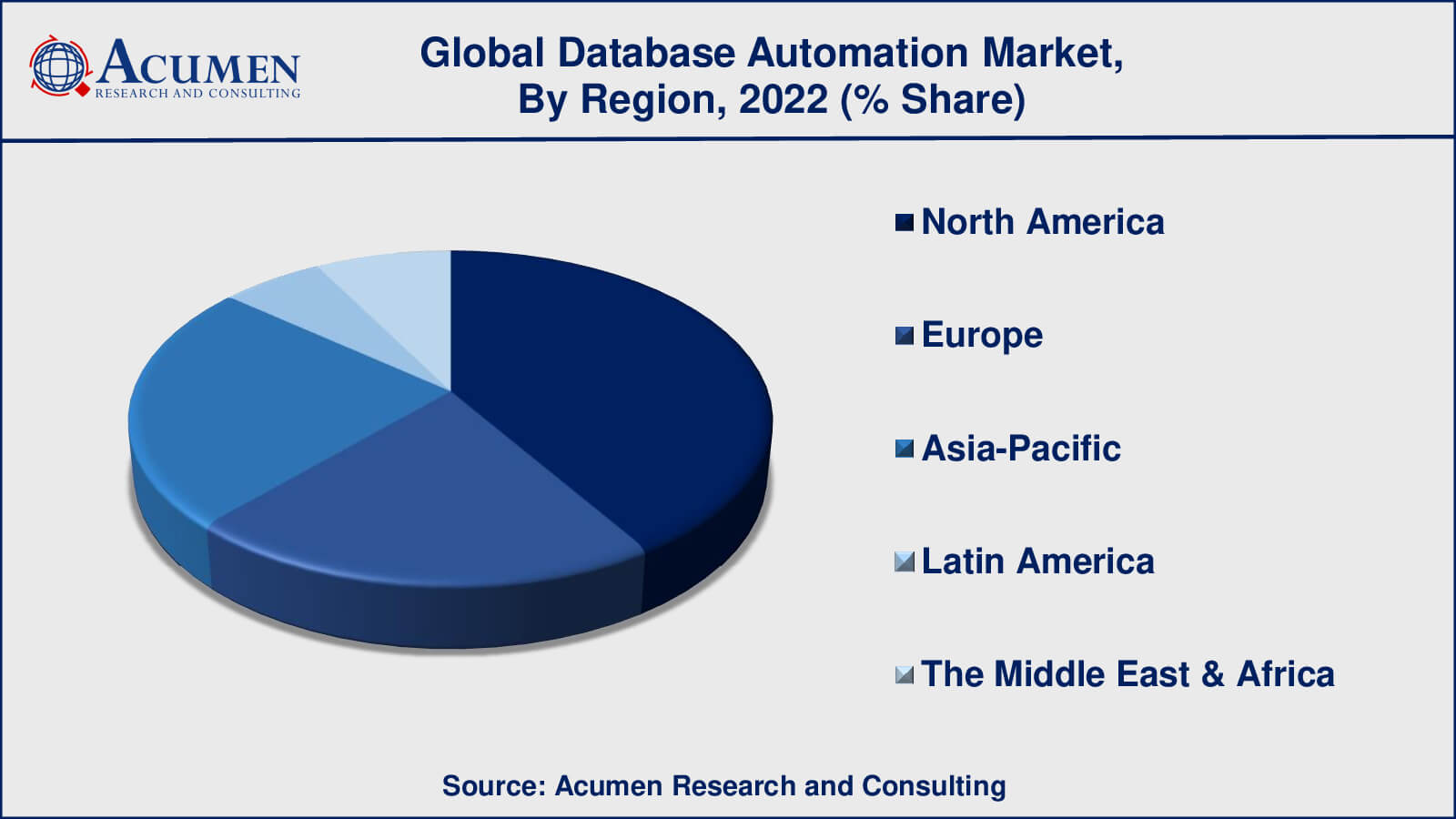January 2023
Database Automation Market size was valued at USD 1,425.9 Million in 2022 and is projected to attain USD 14,833.1 Million by 2032 mounting at a CAGR of 26.7% from 2023 to 2032.
The global Database Automation Market size was valued at USD 1,425.9 Million in 2022 and is projected to attain USD 14,833.1 Million by 2032 mounting at a CAGR of 26.7% from 2023 to 2032.
Database Automation Market Highlights

Database automation is the practice of employing technology and tools to streamline and simplify numerous operations related to database administration and maintenance. It entails the use of software and scripts to automate time-consuming and repetitive operations such database provisioning, configuration, backups, upgrades, and monitoring. Organizations can obtain more efficiency, minimize human mistakes, and enhance overall database performance by automating these procedures. Database provisioning, which includes the generation of new database instances or environments, is an important part of database automation. Automation systems may configure databases with predetermined settings, removing the need for user intervention and maintaining consistency across environments.
In addition, database automation also aids in routine maintenance operations such as backups and upgrades. Organizations may assure data integrity and disaster recovery preparation without depending on human backup operations by scheduling automated backups. Similarly, databases may be updated automatically to ensure that they are constantly up to date with the most recent security fixes and performance upgrades. Furthermore, database automation is also important for monitoring and optimizing database performance. Automation technologies may monitor important metrics and performance indicators in real time, proactively flagging possible problems or bottlenecks. This enables database managers to take remedial measures before severe problems arise, hence enhancing system dependability and availability.

Global Database Automation Market Dynamics
Market Drivers
Market Restraints
Market Opportunities
Database Automation Market Report Coverage
| Market | Database Automation Market |
| Database Automation Market Size 2022 | USD 1,425.9 Million |
| Database Automation Market Forecast 2032 | USD 14,833.1 Million |
| Database Automation Market CAGR During 2023 - 2032 | 26.7% |
| Database Automation Market Analysis Period | 2020 - 2032 |
| Database Automation Market Base Year | 2022 |
| Database Automation Market Forecast Data | 2023 - 2032 |
| Segments Covered | By Component, By Deployment, By Application, By Industry Vertical, By Enterprise Size, And By Geography |
| Regional Scope | North America, Europe, Asia Pacific, Latin America, and Middle East & Africa |
| Key Companies Profiled | Amazon Web Services, Inc., BMC Software, Inc., CA Technologies, Datavail, IBM Corporation, Micro Focus, Microsoft Corporation, Oracle Corporation, Quest Software Inc., and SAP SE. |
| Report Coverage |
Market Trends, Drivers, Restraints, Competitive Analysis, Player Profiling, Covid-19 Analysis, Regulation Analysis |
Database Automation Market Insights
The growing need for effective database administration and maintenance solutions is one of the fundamental reasons driving the market's rise. The requirement for simplified processes becomes critical as firms manage bigger amounts of data and implement more complicated database architectures. Database automation solutions enable organizations to manage their databases more efficiently and decrease operational overhead by automating common processes such as provisioning, backups, and upgrades.
Another key driver of database automation adoption is the increasing complexity of database setups. As businesses use several database technologies, such as on-premises, cloud-based, and hybrid databases, maintaining and integrating these disparate systems can be difficult. Database automation systems provide a single way to efficiently handling various databases, maintaining consistency and coherence throughout the whole data ecosystem.
The growing use of cloud-based databases and infrastructure is driving the database automation industry. Cloud computing has transformed the IT environment by enabling scalable and adaptable solutions. Database automation complements the cloud's self-service and scalability characteristics, allowing organizations to install and maintain databases in cloud settings more quickly and smoothly.
Despite the multiple drivers, the database automation industry is constrained by a number of factors. The high initial installation costs and integration issues involved with deploying automation systems are key roadblocks. Because of financial limits or worries about the difficulty of integrating automated systems with current databases and workflows, organizations may be hesitant to invest in new technology. Furthermore, data security and privacy issues are significant barriers to database automation adoption. Automated systems may involve the storage of sensitive data and the giving of access permissions, generating concerns about possible vulnerabilities and data breaches. Addressing these security problems and establishing strong safeguards becomes critical to ensuring data protection and regulatory compliance.
There are several prospects for suppliers and enterprises in this changing market scenario. With the advent of powerful AI and machine learning technologies, intelligent automation is now possible, allowing database systems to self-optimize and learn from patterns to continuously enhance performance and efficiency. Furthermore, the emphasis on data analytics and real-time data availability opens up opportunities for database automation. Automated systems can guarantee that data is easily available and in the correct format, allowing for timely and data-driven decisions. Furthermore, compliance and governance mandates offer a viable path for database automation. Compliance management may be made more effective by using automated solutions to ensure data consistency, enforce standards, and speed audit procedures.
Database Automation Market Segmentation
The worldwide market for database automation is split based on component, deployment, application, industry vertical, enterprise size, and geography.
Database Automation Components
According to the database automation industry analysis, solutions gathered significant market share in 2022. Solutions often comprise the software, tools, and platforms that offer the real automated capabilities for managing and maintaining databases. These solutions provide a wide range of functions, including database setup, backups, updates, monitoring, and optimization. As organizations seek dependable and effective ways to automate their database operations, vendors offering strong and feature-rich automation solutions can acquire a competitive advantage in the market.
On the other hand, services include professional services, consulting, and support provided by vendors and third-party providers to assist organizations in implementing, integrating, and optimizing their database automation solutions. Installation, configuration, training, customization, and continuing technical support are examples of services. High-quality services and database automation skills may be critical considerations in influencing client decisions, especially for large business projects.
Database Automation Deployments
Cloud deployment refers to the hosting and management of database automation systems on cloud platforms. Cloud-based solutions have various benefits, including scalability, flexibility, lower infrastructure costs, and quick access from any location with an internet connection. Cloud environments' scalability allows organisations to modify resources based on demand, making them an appealing solution for firms with fluctuating database workloads. Furthermore, cloud-based solutions offer rapid deployment and integration, making them appealing to organisations wishing to swiftly streamline their database administration.
In contrast, on-premise implementation entails hosting and administering database automation systems within an organization's own infrastructure and data centres. This method gives firms more control over their data and security, which may be critical in industries with stringent compliance requirements or those dealing with sensitive information. Some organisations may opt on-premise deployment to capitalise on current infrastructure investments or to solve data governance and regulatory compliance concerns.
Database Automation Applications

According to the database automation market forecast, the provision sub-segment is predicted to dominate the market with a significant market share from 2023 to 2032. Database provisioning automation makes it possible to quickly create and configure new database instances or environments. This application is especially useful in scenarios where dynamic scalability and frequent database deployment are required. Automated provisioning simplifies the process of setting up databases using predetermined configurations, saving database administrators time and effort. It is particularly useful in cloud-based and DevOps situations, where agility and speed are critical.
In addition, database backup automation is a critical application for ensuring data integrity and disaster recovery readiness. Automated backup methods assist organisations in protecting their precious data by generating copies of the database on a regular basis, which may be used to recover data in the event of data loss due to hardware failures, software problems, or other unanticipated catastrophes. Furthermore, database security and compliance automation are concerned with ensuring that databases follow security rules, standards, and laws. Automated procedures can monitor access restrictions, encryption settings, and other security measures, assisting in the proactive identification and mitigation of possible vulnerabilities.
Database Automation Industry Verticals
The database automation market is influenced by various factors, including technological advancements, business needs, regulatory requirements, and the adoption of cloud-based solutions. Different industries may have varying levels of adoption and requirements for database automation based on their unique characteristics and challenges. Historically, industries such as banking, financial services, and insurance (BFSI), healthcare, IT & telecommunications, and manufacturing have been early adopters of database automation solutions due to their reliance on extensive data management, security, compliance, and the need for operational efficiency.
Database Automation Enterprise Sizes
As per our database automation industry analysis, large enterprises have historically dominated the database automation market. Large organisations frequently have larger and more complicated database systems than small and medium-sized enterprises (SMEs). They deal with massive volumes of data, requiring effective and automated database administration systems. Database automation enables major companies to simplify their database operations, optimise performance, and assure data integrity and security across several platforms. Large organisations may use automated solutions to manage their data at scale, therefore helping their business development and digital transformation objectives.
Moreover, large enterprises often have larger funds and resources to spend in complex database automation products and services. They can afford to deploy complete solutions that are tailored to their individual requirements, which contributes to the increased use of database automation in this market segment.
Database Automation Market Regional Segmentation
North America
Europe
Asia-Pacific
Latin America
The Middle East & Africa

Database Automation Market Regional Analysis
North America has always been a market leader in database automation. The region's early adoption of automation technologies has been aided by the existence of large technological centers, substantial IT investment, and a strong focus on digital transformation projects. The United States, in particular, has contributed significantly to market growth, with several big organizations implementing database automation to improve efficiency and competitiveness.
Europe has also developed as a significant market for database automation, owing to the region's growing dependence on data-driven decision-making and compliance with data protection requirements such as the GDPR (General Data Protection Regulation). Countries such as the United Kingdom, Germany, and France have expressed a strong interest in database automation technologies to help them manage their growing data volumes while also ensuring data security.
The Asia-Pacific region displayed significant development potential in the database automation industry. Rapid digitalization, increased IT expenditures, and the adoption of cloud-based solutions in countries such as China, India, Japan, and South Korea have spurred the desire for automation to handle the massive volumes of data created by the region's businesses and organizations.
Database Automation Market Players
Some of the top database automation companies offered in our report include Amazon Web Services, Inc., BMC Software, Inc., CA Technologies, Datavail, IBM Corporation, Micro Focus, Microsoft Corporation, Oracle Corporation, Quest Software Inc., and SAP SE.
Looking for discounts, bulk pricing, or custom solutions? Contact us today at sales@acumenresearchandconsulting.com
January 2023
January 2025
February 2023
August 2020